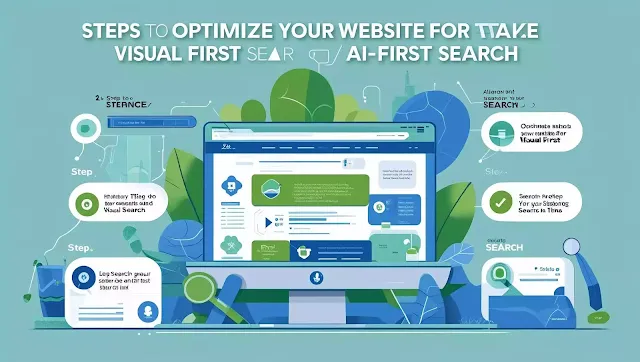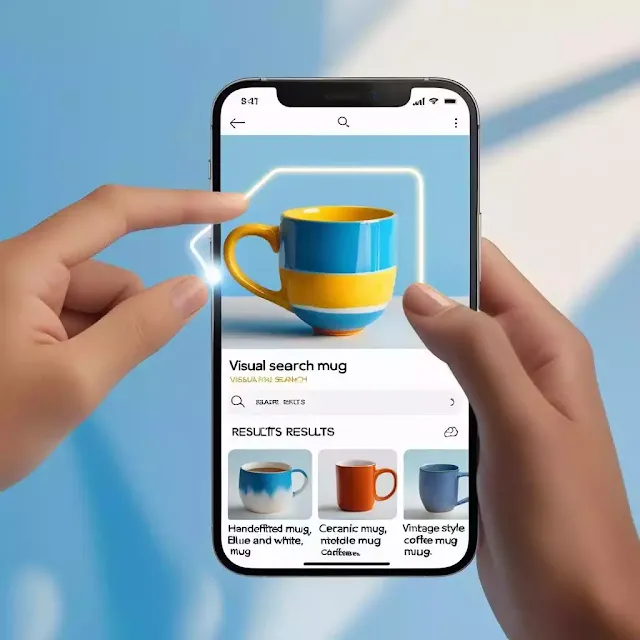How To Setup Visual Search Optimization with AI First Search Feature in your Website?
Its July of 2025 and We are at the forefront, of the new revolution which is on for some time but still evolving - The AI Search mania.

I have been exposed to the Internet and its core technologies since 1998, understanding How it works, how it can help the masses. help the World of questions and how it can serve all of us.
AI is making every aspect of Life on Earth a need and necessity of All the Profession out there.

Here's a breakdown of the future for you as a publisher in this visual-first landscape:
Since the start of ChatGPT in November 2022, the Way we search the Internet, the Way we feel to ask questions on the Internet (Basically through Search on Google or Bing) has changed a lot.
Its July of 2025 and We are at the forefront, of the new revolution which is on for some time but still evolving - The AI Search mania.

I have been exposed to the Internet and its core technologies since 1998, understanding How it works, how it can help the masses. help the World of questions and how it can serve all of us.
 |
| Timeline Evolve of Internet Browser Smartphone Apps and now AI |
But Nothing so Profound and bold like AI, I have seen.
Had witnessed the evolution of Browser from DOS black screen to the invention of visual Browser - Netscape. The Prominence of Websites with HTML and then the core TAGS that it manages to Show the Wao -- Colors and images.
AI is making every aspect of Life on Earth a need and necessity of All the Profession out there.

While AI can assist, human oversight is crucial to ensure authenticity, quality, and relevance in your visual content. AI should be an assistant, not a replacement.
Visual-first search is indeed booming and represents a significant shift in how users discover information, products, and content online. For website and blog article publishers, this isn't a threat but a critical evolution that demands adaptation and strategic thinking.
Here's a breakdown of the future for you as a publisher in this visual-first landscape:
The Rise of Visual-First Search: Key Drivers and Trends
- AI and Computer Vision: The underlying technology, powered by advanced AI and machine learning (especially deep learning and CNNs), allows visual search engines (like Google Lens, Pinterest Lens, Amazon Visual Search) to accurately analyze images, identify objects, understand context, and even interpret abstract concepts like sentiment.
- Mobile-First World: The ubiquitous use of smartphones with high-quality cameras makes it incredibly easy for users to snap a picture and search, bypassing the need for complex text queries.
- Instant Gratification: Users want quick, intuitive solutions. Visual search offers a frictionless path from discovery to information or purchase, especially in e-commerce, fashion, home decor, and travel.
- Multimodal Search: The future isn't just visual or just text, but a combination. AI is enabling multimodal search, where users can combine images with text keywords to refine their queries and get highly personalized results.
- Trust and Engagement: Studies show consumers often find visual information more trustworthy and engaging than purely textual content, especially for shopping. Authentic, relatable visuals are outperforming highly polished campaigns.
- Discovery-Driven: Visual platforms like Pinterest are increasingly becoming discovery engines where users explore interests and find inspiration visually, rather than just searching for specific items.
The Future for Website and Blog Article Publishers: Adaptation is the Key
The shift to visual search doesn't mean the end of text-based content, but it does mean that visuals will play an even more crucial role in how your content is found and consumed.Here's how you can adapt:
1. Optimize Your Visuals (Beyond the Basics)
- High-Quality, Engaging Images: This is paramount. Use clear, high-resolution, visually appealing images. Prioritize original photography over generic stock photos to differentiate your content.
- Descriptive Filenames and Alt Text: Still crucial for SEO. Use descriptive filenames (e.g., best-gluten-free-pasta-recipe.jpg instead of IMG1234.jpg) and write detailed, keyword-rich alt text that accurately describes the image content. This helps search engines understand your images.
- Structured Data Markup (Schema.org): Implement schema markup for your images, especially if you're featuring products, recipes, or events. This provides search engines with valuable context and can lead to rich results in image search.
- Image Sitemaps: Ensure your images are included in an image sitemap to help search engines discover and index them efficiently.
- Optimize File Sizes and Formats: Compress images without sacrificing quality to ensure fast loading times. Use modern formats like WebP. Fast loading speeds are crucial for both user experience and SEO.
- Contextual Content: Search engines analyze the text surrounding images for relevance. Ensure your blog post content provides a strong textual context for your visuals.
- Mobile Responsiveness: Your images and overall website must be optimized for all devices, especially mobile, where visual search is heavily utilized.

2. Embrace Diverse Visual Content Formats
- Infographics: Excellent for conveying complex information visually. Animated infographics can be even more engaging.
- Videos (Especially Short-Form): Video content is exploding. Incorporate short-form videos (like Reels, TikToks) into your blog posts. Remember to add captions and text overlays as many users watch with sound off.
- Explainer Visuals & Animated Content: Use motion and interactivity to break down processes, make data digestible, and keep users engaged. Think scroll-triggered animations and hover effects.
- Interactive Elements: Consider interactive images, comparison charts where users can toggle options, or even AR elements if relevant to your niche (e.g., trying on clothes virtually).
- Lifestyle Imagery: If you feature products, showcase them in lifestyle settings to help users visualize them in real-world contexts.

3. Focus on User Intent and Experience
- Address Visual Search Queries: Think about what kinds of visual queries your target audience might use to find your content. For instance, if you write about interior design, users might search for "modern living room with blue sofa" using an image.
- Solve Visual Problems: Can your blog help users identify something they see? Can it provide inspiration based on an image they have?
- Prioritize User Engagement: Beyond page views, focus on metrics like engagement time, return visitor rates, and community participation. High-quality visuals contribute significantly to these.
- Personalization: Leverage data to offer personalized visual recommendations or content.
4. Leverage AI Responsibly
- AI-Powered Image Optimization: Utilize AI tools for image adaptation, resizing, background removal, color correction, and smart compression to streamline your workflow and ensure visual quality.
- AI for Content Inspiration: AI can help brainstorm visual content ideas and even generate initial drafts for visual elements.
- Human Oversight: While AI can assist, human oversight is crucial to ensure authenticity, quality, and relevance in your visual content. AI should be an assistant, not a replacement.
5. Diversify Your Traffic Sources and Platforms
- Beyond Google Images: While Google Images is important, consider optimizing for platforms like Pinterest Lens, which is a powerful visual discovery engine, especially for lifestyle, fashion, and home goods.
- Social media: Social platforms are inherently visual. Actively share your visual content on Instagram, Facebook, Pinterest, YouTube, and TikTok to drive traffic back to your blog.
- Direct Traffic & Newsletters: Continue to build direct relationships with your audience through email newsletters and strong brand presence to reduce reliance on search engines.
So to conclude, we can say visual-first search is a powerful force that will continue to shape the digital landscape
And for website and blog article publishers, the future is about embracing this visual revolution, strategically optimizing your content, diversifying your visual formats, and prioritizing an engaging user experience.
Those who adapt will not only survive but thrive in this evolving environment of the Future.



Comments